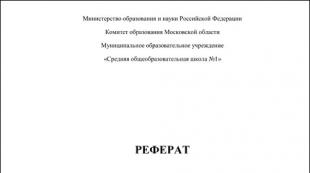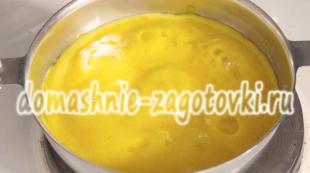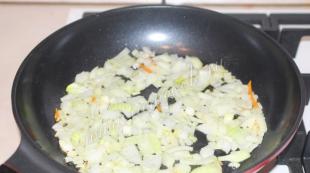Design of a title page for biology. Rules for writing abstracts in biology
In general, a report is not difficult to write and format; it is more difficult to give a good report in front of a class or audience.
When designing the title page of a school report, you should adhere to a strict style. It is preferable to use classic colors: black font on a white background.
If the printed pages of the report will be stapled on the left side, then when preparing the title page it is necessary to leave a space intended for a binder - a margin of 3.5 cm.
The preferred line spacing is 1.5, font is Times New Roman.
Title hat
At the very top of the first page the name of the higher educational organization should be written. The next line is the name of the school of the student performing the report.
Type and topic of work
In the middle of the title page is the name of the type of scientific work being performed - in this case, it is a report. The topic of the report is written below.
The topic must be correctly formulated. If possible, it should define the specific boundaries of a given topic and its clarification. It is advisable to avoid such formulations as: “Creativity of A.P. Chekhov", "Fauna and Plants of Eurasia", "Water World". It is impossible to cover such topics in one report, so it is worth specifying them: consider some of the works of A.P. Chekhov, certain groups of animals or plants of Eurasia, the largest seas in the world, or interesting facts about aquatic animals.
The font in which the word “Report” is written on the title page may be larger than the font of the rest of the text. When writing a topic, it is common to use a smaller font.
Specify the type of work “Report” and write the topic
Regalia of student and teacher
Below the title of the topic, on the right side of the sheet, write your full name. student and his class. The next line is your full name. teacher who will check the report.
City and year of writing
At the bottom of the title page is the name of the student’s place (locality) and the year in which the report was prepared.
Let's sum it up
Competent design of any scientific work, including a report, allows you to strengthen the overall positive impression of the work and increase your grade. In the article, we examined in detail each element of the title page of the report. To avoid having to re-enter all the fields, download the ready-made sample:
How to design a title page for a report at school if you don’t know how to do it updated: February 15, 2019 by: Scientific Articles.Ru
Preparation of the abstract
1. Job opens title page, where the full name of the educational institution, subject, topic of the abstract, surnames of the author and director, place and year of writing are indicated.
2. The total volume of the abstract should not exceed 15-20 pages for the printed version.
Select allCTRL + A,
Format - Paragraph -
- width alignment.
- First line – indent – 1.25 cm;
- Line spacing is one and a half (1.5 spaces).
Format - Font –
- Times New Roman,
- font size - 14 pt.
File - Page settings - Page margins: left - 3 cm, right - 1.5 cm, bottom 2 cm, top - 2 cm.
3. Each structural part of the abstract (introduction, main part, conclusion, etc.) begins on a new page ( Insert - Break - New Page).
4. There is no period after the title. Headings are numbered in Arabic numerals with a dot.
5. Abstract pages are numbered in ascending order. Page numbers are placed at the bottom in the middle of the sheet. Insert - Page Numbers - Bottom of Page; From the center; The number on the first page is not indicated (remove the mark) (this does not apply to the content of the abstract).
6. The completed abstract must be bound.
WITHstructure and content of the ABSTRACT
The abstract must have the following structural elements:
title page;
introduction;
main part;
conclusion;
bibliography;
applications (if necessary).
The title page is the first page of the abstract and is filled out according to certain rules
In the introduction it is necessary to formulate the essence of the problem under study, justify the choice of the topic of the abstract, give a brief description of the genre of primary sources (research, monograph, article, review, textbook, etc.), formulate the goals and objectives of this work.
In the main part the main provisions of the chosen topic are revealed in accordance with the studied literature. If the abstract raises several problems, you can arrange the material of the main part in several chapters, giving them suitable titles. The author of the abstract must indicate what solutions to problems are proposed by the authors of the primary sources, note the existing points of view on the problems under consideration and express his own opinion, developed on the basis of an analysis of the primary sources. Quotations and references should not replace the position of the author of the abstract.
In custody it is necessary to draw your own conclusions on the problems, assess the relevance of the problems raised in the primary sources, and express agreement or disagreement with the position of the authors of the primary sources.
Bibliography contains a list of literature only used in the abstract.
In applications tabular materials, drawings, graphs, regulatory and other documentation are placed, on the basis of which the analysis and conclusions are drawn in the work, and other materials.
1. What is an abstract and for what purpose is it written?
The word "abstract" comes from the Latin referre, meaning “to report”, “to inform”, and has several meanings. The basic meaning of this word refers to a summary of the contents of a book, article, or some other work.
Another meaning of this word is more important to us - by abstract we will understand a theoretical work based on already known facts, in which a topic is more or less fully revealed. In fact, this is an article that briefly presents already known (published) information on a selected topic, subject, direction. Therefore, the abstract involves the use of literary sources.
What is the purpose of writing abstracts? A teacher, inviting a student to write an essay, expects that he will delve more deeply into the essence of the subject, expand his knowledge on it, and if he also makes a message (report) on the topic of the essay, he will share his knowledge with others. By inviting a student to write an essay, the teacher wants to teach him to work with information: collect material (literature) on a given topic, systematize it, highlight the main thing, consistently and logically present the essence of the subject. Working on an essay allows you to gain a deeper understanding of the topic, better assimilate it, and develop the skills of organization and determination necessary when studying any subject.
A student who takes up writing an essay usually has one goal: to get a good grade. Getting a good mark if you worked hard and did your job honestly is quite fair. It is good if at the same time the student has a desire to expand and deepen his knowledge of the subject.
At first, the student may have another goal - to learn how to work on an essay. Don't think it's that simple. You must be able to write an essay.
2. Choosing a topic
In order to write an essay, you first need to choose a topic. The teacher can suggest a topic, or you can choose it yourself. When choosing a topic, you should be guided, firstly, by whether it interests you, and, secondly, by whether you can find literature on this topic. Therefore, take your time: look at what literature is available on the issue you are interested in at home and what you can find in the library. When searching for literature in the library, subject catalogs can help. Ask your bibliographer or librarian how to use them. When you pick up a book that interests you, first read the abstract and table of contents to find out what issues are discussed in it.
If you choose a name that has a broad meaning, then you need to focus on comprehensive coverage of the subject: write about a lot, but briefly, without going into details, i.e. about the most important thing. If the topic is formulated narrowly, then in addition to general information, the abstract may contain individual details.
3. Work on the abstract
Let's assume you've chosen a topic. What to do next?
Most guys do this. Let's say the theme “Mushrooms” is chosen. The student takes the “Encyclopedia for Children” or some other book where something is written about mushrooms, and begins to copy the relevant sections from it. Diligent students rewrite everything, but not particularly diligent students are too lazy to rewrite everything, and they miss out on some paragraphs. I’ll say right away: both of them are doing it wrong. Such rewriting does not benefit anyone, but only takes time away from both the one who writes and the one who checks.
Where to start? First of all, you need to make a plan. First a rough draft, for myself, so that I know what to write about and in what order. You can use a school textbook as an initial source of information. Familiarize yourself with the contents of the books you have selected and choose material that can supplement the information in the textbook. At the same time, you may want to slightly clarify or change the original outline of the essay.
In general, the structure of any abstract should be approximately as follows:
1. Introduction – justification of the relevance (importance) of the chosen topic.
2. The main part is a general description, description and analysis of the subject (phenomenon), preliminary conclusions.
3. Conclusion – final conclusions.
Let's discuss the contents of these sections in more detail.
3.1. Introduction
Any abstract must have an “Introduction”. It can be small and consist, for example, of just one paragraph, or it can include several paragraphs or even a whole page, or even more. If the work is small, then the introduction should not be large.
Already the title of the section “Introduction”, the meaning of the word itself, speaks of the need to introduce what will be discussed in the abstract. Here it should be noted why this topic is interesting or important, and highlight the main issues that are supposed to be considered. For example, if you chose the topic “Mushrooms,” you can say that mushrooms are a kingdom of living organisms that have characteristics that distinguish them from both plants and animals, and which play a very important role in nature (the Earth’s biosphere). This means that the main content of the essay will be aimed at showing how mushrooms differ from plants and animals and what role they play in nature.
Thus, in the “introduction” you provide the most general information about the subject (problem) and talk about why this subject (problem) is important.
3.2. Main part
This requires a detailed plan. It is necessary to carefully consider the structure of this part, to build a sequence of presentation so that it does not turn out that you first talk about one thing, then another, a third, then return again to the first, mention the third and fourth, and again something about the first - in a word, so that there is no confusion or confusion in your presentation.
Let's see how you can make a plan for the same topic “Mushrooms”. First you need to give a general description of the kingdom of fungi, show their systematic position in the world of living nature (fungi belong to the superkingdom of eukaryotic organisms), show how they differ from living organisms belonging to other kingdoms. This point of the plan can be written like this: “1. General characteristics of the kingdom of mushrooms."
Next, you need to talk about what types of mushrooms there are in terms of their structure. So let’s write it down: “2. The structure of mushrooms. Features of the structure of a fungal cell." Here we must not forget to talk about the structure and composition of the cell membrane of fungi, what is a reserve polysaccharide in fungi, how a fungal cell differs from a plant and animal cell, and what it has in common with both.
Now let's move on to the properties of mushrooms. You know that we usually talk about eight properties of living organisms: nutrition, respiration, excretion, growth, development, reproduction, movement and irritability. But not all living organisms must have all these properties. Let's see how things are with mushrooms. Let's start with nutrition.
So, with the first paragraph of section “3. Properties of mushrooms” we did it. Let's move on to the second - “Breath of Mushrooms”. This point will be shorter. Here it is enough to recall the two types of respiration - aerobic and anaerobic - and say which fungi are capable of anaerobic respiration (yeast) and how fungi absorb the oxygen necessary for aerobic respiration.
Now about excretion: mushrooms, just like plants, unlike animals, do not have special systems or organs of excretion. Substances they do not need are removed through the surface of the body.
Next we should discuss three properties that are caused by cell division: growth, development, reproduction. A feature of mushrooms is apical growth and the ability to grow throughout life - just like plants. Speaking about the reproduction of mushrooms, it is necessary to mention what methods of reproduction generally exist in nature (sexual and asexual) and which of them are found in mushrooms. It is advisable to present a general diagram of the methods of reproduction of fungi, and then give examples of which method of reproduction is typical for which fungi, which fungi alternate between sexual and asexual reproduction, and which fungi are characterized by predominantly asexual reproduction.
For such properties as movement, development and irritability, it is not worth highlighting separate points, because some of them are missing, while others can be mentioned when talking about fungal growth.
Then you can move on to the taxonomy of fungi, which is based, on the one hand, on their structure (lower and higher fungi), and on the other, on the characteristics of reproduction (ascomycetes, basidiomycetes, deuteromycetes).
Now let’s see what plan we have for the main part of the essay on the topic “Mushrooms”:
1. General characteristics of the fungal kingdom.
2. The structure of mushrooms.
3. Properties of mushrooms.
3.1. Nutrition.
3.2. Breath.
3.3. Selection.
3.4. Height.
3.5. Reproduction.
4. Classification of mushrooms.
5. The role of mushrooms in nature and human life.
As you can see, there are five sections, and in the third section there are five more points, but in the final plan these points can not be indicated or highlighted with subheadings in the text, or they can be highlighted as you want.
Please note: we designated the points with two numbers separated by a dot, the first is the section number, and the second is the point itself. If in some paragraph we wanted to highlight subparagraphs, then we would have to designate them with three numbers, separated from each other by dots, the first is the section number, the second is the paragraph, the third is the subparagraph. This notation is convenient if there are many gradations in the text. If there are not so many of them, then you can use a letter with a bracket to indicate the point, for example, a), b), c), etc.
3.3. Conclusion
Now let's move on to the final part of the essay. Usually it is called: “Conclusion”, but it can also be called differently: “Conclusions”, or even like this: “Conclusion and conclusions”. In the “Introduction” the problem is outlined in general terms, in the “Main Part” everything that is related to this problem, phenomenon is described in detail, and now we need to draw conclusions, i.e. Briefly answer the questions that were posed in the “introduction” and “main part”.
“Conclusion” is written in continuous text in the form of narrative sentences, for example, like this:
Conclusions are presented in the form of separate points indicated by numbers.
1. Fungi are a separate kingdom of living organisms that differ from plants and animals.
2. Fungal cells, like plant cells, unlike animal cells, have a thick cell wall, but it does not consist of cellulose, but of another polysaccharide - chitin. Fungal cells do not have plastids; the storage polysaccharide, like in animal cells, is glycogen.
3. Just like animals, fungi are heterotrophs, but unlike animals, they absorb food without capturing it, but by absorbing substances previously broken down outside the body.
4. Mushrooms, like plants, are characterized by apical growth.
5. Mushrooms, with rare exceptions, are aerobes. Just like plants, they do not have special systems for removing unnecessary substances.
6. The main role of fungi in the Earth’s biosphere is the role of decomposers. They also play an important role in human life, being a source of antibiotics and an important component in the production of some food products.
4. Bibliography
Well, now let's talk about the very last, but very important section of the abstract - about the bibliography, or more simply - about the literature used in writing the abstract. All this literature should be listed at the end of the abstract in a section called: “Literature”, or “Bibliography”, or “Literature Used”. All books, textbooks, magazine articles or newspaper reports that were used as a source of information should not only be listed, but each of them should be given a full bibliographic reference.
What is a bibliographic reference? This, figuratively speaking, is the address where this book (article, note) can be found. It must contain the surname and initials of the author, the full title of the book, the place of publication (if it is Moscow, then M. is written, if St. Petersburg, then St. Petersburg, the names of other cities are written in full, for example, Minsk), then the publishing house is indicated after the colon , then separated by a comma, the year of publication in numbers without writing the word “year” and the page on which the information used is presented, for example, p. 8–11 (note: the word “page” is not written in full, but only the letter “s” and a period). Let's give an example: Mednikov B.M. Biology: forms and levels of life. – M.: Education, 1994, p. 33–36.
If you need to give a bibliographic reference to an article in a journal, then after the surname, initials of the author and the title of the article, put a dot and a diagonal stick. Then write the name of the journal in which this article was published, the year of publication, indicate its volume (if any), number, page numbers on which the article was published, for example: Dyakov Yu.T. Mushrooms and their significance in the life of nature and man. Soros educational journal/1997, No. 5, p. 38–45.
5. Quoting
To quote means to quote. You, of course, know what a quotation is - it is a [verbatim] excerpt from any text. I took the word “literally” in brackets, because when you write an abstract, you always quote the authors whose books, articles, notes you use, but sometimes you quote their words verbatim, and sometimes you change the wording, maintaining the meaning.
If you use few sources, say, one or two, then it is enough to provide a bibliographic reference to them at the end of the abstract. If there are many sources, then it will be very difficult for the person reading the abstract to figure out where and which author you are citing. Therefore, references must be made in the text of the abstract itself. There are several different ways to quote. Let's point out some of them.
1. In the text, after presenting the thoughts or point of view of any author or information taken from a given source, at the end of the last sentence you indicate the author’s surname in brackets and there, separated by a comma, the year of publication. The reference list lists the works cited, with bibliographic references arranged in alphabetical order.
2. In the list of references, cited works are arranged in alphabetical order, but each of them is preceded by a serial number. The text in round or square brackets does not indicate the name of the author, but the number under which his work appears in the list of references.
The first two citation methods are suitable for an abstract. The latter is used, as a rule, in books, sometimes in articles.
Sometimes it is important not just to retell some idea of the author, but to accurately reproduce its wording, then the quote must be enclosed in quotation marks and, after the quotation marks, a link must be made using one of the above methods.
6. Preparation of the abstract
It is advisable that the volume of the abstract does not exceed 10 printed pages. The optimal length is 5 pages, but the main content of the abstract should occupy at least two pages. The text of the abstract is written or printed on one side of standard sheets of white paper (A4 format). Margin sizes: left - at least 30 mm, right - at least 10 mm, top and bottom - 25 mm each.
The abstract must have a title page, which is formatted as follows:
– at the very top of the sheet, departing 25 mm from the top edge, write the name of the institution where the work was carried out, that is, the full name of the school;
– in the central part of the page we write in capital letters: ABSTRACT ON BIOLOGY;
– a line below – words on the topic, after which we put a colon;
– below is the full title of the abstract topic in capital letters without quotation marks and without a period at the end;
– in the lower third of the sheet on the left we write the Performer, on the right – the student’s first and last name, class;
– even lower on the left – the Head, on the right – the initials and surname of the teacher;
– at the end of the page we indicate the place where the essay was written and the academic year.
The title page is included in the general page numbering; the page number is not indicated on it. The title page is followed by an outline of the abstract, which lists all its sections in the order they appear. Headings of large sections are written in capital letters without a period at the end, without underlining, and are placed symmetrically relative to the center of the line. Headings of subsections and paragraphs should begin with a paragraph indent and be printed in lowercase letters, starting with capital letters, in space, without underlining, without a period at the end. Hyphenation of words in headings is not allowed. There should be extra spacing between the main sections heading and the text.
Literature
1. Guidelines for students of the plant protection department: “Course work in agricultural phytopathology.” Compiled by: V.A. Shkalikov, Yu.M. Stroikov. – M.: MCHA, 1992, 16 p.
2. Kulev A.V. How to write and format an abstract paper / Biology at school, No. 2, 1995, p. 33–35.
3. Mikhailova S.Yu., Nefedova R.M. Abstracts, abstracts, presentations. – M.: 1998, 256 p.
4. Research report: Structure and formatting rules. GOST 7.32-91. – M.: Standards Publishing House, 1991, 18 p.
5. Dictionary of the Russian language. In 4 volumes. T. 3. – M.: Russian language, 1983, p. 711.
6. Vasmer M. Etymological dictionary of the Russian language in 4 volumes. T. 3. – M.: Progress, 1986, p. 476.
To be continued
Any work, such as a diploma, coursework or essay, begins with a title page. There are generally accepted rules for the design of such first sheets. We suggest downloading the sample title page that you need.
- all title pages are presented in Word, on an A4 sheet;
- any sample can be opened even in an old version of Word, as they all have the DOC file extension;
- you can easily download and edit the submitted title pages.
Title page for abstract

On the title page of the sample for writing an essay, you must type your subject, topic, number and letter of the class, as well as your last name and first name. You can download the title page for the abstract at.
Title page for term paper

The first page for term papers is slightly different from the title page for essays. Coursework is never assigned in schools, but it is required to be completed frequently in higher education institutions. The title page presented above is suitable for most establishments in the Russian Federation. Free download at .
Title page for thesis

Just as a person is greeted by his clothes, your thesis work will be assessed primarily by its appearance, in particular by the title page. For a thesis, it is very important that the title page is designed in accordance with a specific GOST. But the problem is that many institutions and professors do not adhere to the current parameters for the design of theses, and it happens that they compare your work according to GOST, which was 10, or even 20 years ago. Therefore, it is best to take a sample from the leader of your thesis project. In any case, the most correct example of a title page for a diploma is possible.
Before you get started, you need to understand what an abstract is.
An abstract is a short oral or written presentation of scientific facts, literature read, and so on.
A correctly written abstract is distinguished not only by interesting content, but also by competent design. That is why it is so important not only to write the abstract correctly, but also to format it properly.
All requirements and standards for writing an abstract and an example can be found in GOST or methodological developments at the department. However, all documents allow for the caveat that each educational institution reserves the right to change some points. Therefore, before starting work on your essay, make sure that our recommendations do not conflict with the requirements of your university.
The preparation of an essay in English is done according to all the rules listed below, unless your department has separate requirements.
Writing Requirements
It is necessary to study the structure of this type of work. So, the standard abstract includes:
- Title page. “Judge by the cover” - do not forget this rule when writing an essay. Therefore, the title page must be completed according to all the rules. Do not forget to indicate your full name, name of the department and university, as well as the topic of the work and the date of submission.
- Content. Here is a list of subtopics, subparagraphs, paragraphs, columns and other components of the abstract, indicating the pages on which they are located. We number all pages except the title page and contents.
- Introduction. It is necessary to write the beginning of the essay from this part. Here you indicate what the report will be about and why this topic was chosen. Determine goals, objectives and methods by which the tasks were solved.
- Chapters. Each chapter of the abstract is completed from a new page.
- conclusions. Here are the author's conclusions and conclusions about the work done.
Title page design
The purpose of the title page of an abstract is to give the reader all the necessary information. The required information means:
- The topic of the study and the course within which it was conducted.
- Faculty and department.
- Data from the author and supervisor.
- The name of the institution.
- Date, location, defense of the study.
If you want to do everything right, the title page should be:
- coherent and holistic in content;
- informative;
- competently designed.
How to write goals and objectives: rules and example
The purpose of the essay directly depends on the topic. If the topic is correctly composed, then there will be no problems with setting goals and objectives. It is important to distinguish between these concepts in order to know how to correctly write the purpose and objectives in the abstract.
Target is what you want to achieve as a result of the research.
Tasks- these are the specific steps-subgoals with the help of which the overall goal is achieved.
The goal should be general, clear, concise and achievable. Tasks are unique subgoals, which in no case should repeat the goal.
In addition, the objectives must be specific. A detailed action plan will help you set goals and objectives and correctly disclose them in the report.
Any scientific work requires a clear plan. It structures the information, displays the specifics of the topic and indicates its key provisions. And the teacher does not sleep, but carefully studies the plan of your essay and draws conclusions about how correctly it is drawn up.
How to write an essay plan in order to correctly build the concept of its composition?
The plan should be clearly structured and consistent in order to immediately have an idea of what will be discussed in the abstract.
In the process of drawing up the plan, the main issues that are covered in the work are identified. There are usually several such questions, which are displayed in points in the plan. With their help, the essence of the problem posed in the topic of the abstract is revealed.
How to write content: rules
It all starts with the design. Since the content is the second page of the work, teachers pay close attention to it. Even the main part cannot boast of such honors.
To find out how to correctly compose the content of an abstract, you should refer to GOST. State standards clearly define the standards for formatting any scientific work.
Abstract structure:
- introduction;
- chapters and paragraphs of the main part;
- conclusion;
- bibliography;
- applications.
The standard content font is Times New Roman. Size - 14 pt. The font can only be changed if the entire work is printed in the same font. The interval is one and a half. Indentations and margins are maintained throughout the work.
What to write in the introduction
What is the function of introduction? This section opens the abstract and interests the audience in the chosen topic, introduces it to the purpose, objectives, relevance, object and subject of the abstract.
What to write in the introduction to an abstract?
- Relevance- explain why this particular topic was chosen and how relevant it is in the modern world.
- Goal and tasks- explain why this work is being written, what result you want to achieve and by what methods.
- Object and subject- determine what the work will be about and what specific areas will be studied.
- Research methods- indicate ways to study the material.
- List of sources- list articles, textbooks, scientific works, monographs and other literature that will be used in the abstract.
- Work structure- outline a work plan.
Do you want to write a high-quality introduction? Then save this part of the work for last. First, study the main part, analyze the literature sources, identify the main authors, and only then decide on the object and subject of the work, set a specific goal and prescribe the steps to achieve it.
How to write a conclusion in an abstract? Many students want to know the answer to this question. After all, GOST and methodological manuals do not provide rules for the format and content of the conclusion. By the way, the conclusion is the most important part of the abstract, since it summarizes and structures all the material.
Conclusion is the conclusions that are based on the objectives and purpose of the study.
The result (conclusion) of the abstract is conclusions related to the purpose and objectives with personal assessment and one’s own conclusions. The main feature of the conclusion is the following: conclusions are formulated in your own words, and not quoted as phrases from parts of the work. The results in the conclusion must be justified and supported by facts from each section of the abstract.
How to write a conclusion? Strictly and scientifically. The conclusion is presented in a scientific style: without personal pronouns and “water” words - only facts and your own conclusions.
General requirements for the preparation of an abstract
The text of this type of work is created on a computer using the Microsoft Word office application. You can write your abstract by hand, but it is not necessary. Firstly, no one demands this from you, and secondly, it is very energy-consuming.
- Write an abstract 12 or 14 font size Times New Roman. At the same time, maintain one and a half line spacing.
- Before you start creating text, set the margin sizes in the settings: top margin – 10-30 mm, lower – 20-30 mm, right – 15 mm, left – 20-25 mm.
- All pages of the abstract must be numbered. The only two pages that are not numbered are the title page and the contents page. The introduction page is numbered 3.
Capital letters
The following may be indicated in capital letters:
- the word “abstract” and the name of the topic on the title page;
- names of chapters and paragraphs.
Bold font
The topic on the title page, the name of the structural elements (contents, introduction, chapters, conclusion, list of references), as well as words in the text that need to be emphasized, can be highlighted in bold. Italics can also be used for this.
Interval
When writing an abstract, use spacing. 1,5 . Increasing the spacing is also unacceptable, as is increasing the font size. It is allowed to increase the interval between the title of the chapter and section.
Paragraph indentation
When presenting thoughts sequentially, the work is divided into paragraphs. Each new thought is a new paragraph, which begins with an indentation 1-2 cm (usually 1.25).
Alignment
The text of the work is aligned in width, headings are aligned to the center or left with a paragraph indent.
Formatting mathematical formulas in an abstract
Students should pay special attention to formulas. If you are preparing an abstract in Word, type formulas using the built-in Microsoft Equation tool or the MathType editor.
Each formula must be numbered and start on a new line.
There is no need to confuse student and postgraduate essays. A postgraduate abstract is a much more in-depth research paper. Read about writing and formatting a scientific abstract for graduate school in our separate material.
Rules for preparing a bibliographic list
- If the sources include legislation, decrees or laws, they should always be placed first in the list. All remaining publications will follow them.
- All sources are arranged in alphabetical order.
- The list of sources must be numbered (Arabic numbering), with a dot and a space after the number, after which the source itself is indicated.
- If, when creating an abstract, a student used sources in a foreign language, they should be placed in a separate list after the main literature. The author's full name should be indicated first (foreign entries also appear in alphabetical order), and then the source itself (book title).

When describing the source itself (domestic or foreign), you should adhere to the following order of data:
- Last name and initials of the authors.
- Title of a book or other printed source (without quotes).
- Repetition of the author's surname and initials (if there is only one author) or indication of the same data from co-authors, compilers of the source.
- City of publication (in full or abbreviated if we are talking about Moscow or St. Petersburg).
- Year of publication without the letter “g”.
- The total number of pages, as well as the page on which information was cited or used.
Image design
Typically, an abstract does not require images to be placed in the main text. The fact is that this work is considered an oral form of report, which is designed to assess the student’s knowledge and check the depth of his understanding of the topic covered.
However, in some cases, the abstract may contain images. In this case, they can be formatted as appendices to the work, which appear at the end of the main text on separate sheets or within the text itself.
If a picture (graph or table) is inserted into the main text, it must certainly be numbered.
How to create links
– a mandatory element of any scientific work. If you use them within the body of the text, you should include the link in square brackets immediately after the sentence to which it refers.
Inside the square bracket is a serial number, which corresponds to the page number and source number from the bibliographic list.
For example:
If it is necessary to use a quotation in the text, then square brackets are also placed at the end of it, inside of which:
- serial number of the source from the bibliographic list ,
- page number .
Title subtleties: “contents” or “table of contents”?
One of these concepts is used depending on the type of work the student is writing.
Thus, the word “Table of Contents” is used in those works where each subsequent section is connected with other parts in meaning (in an abstract, coursework, dissertation).
But is it worth worrying and spending sleepless nights trying to write an essay on your own, when you can turn to a professional service for students? The decision is yours! And to broaden your horizons or just keep up to date with student life, subscribe to our









